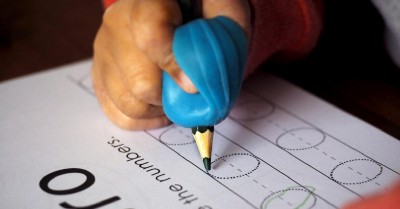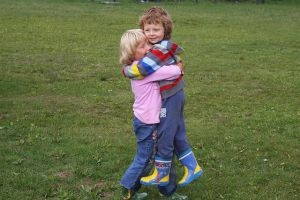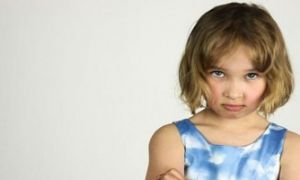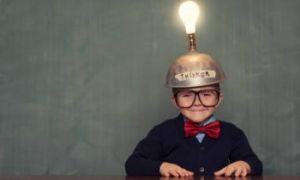Writing ability is one of the more complex literacy skills as it depends on a host of physiological, cognitive and communication developments. The following article provides information on the role of drawing and talking in early writing development.
Drawing and Early Writing Development
Drawing is one of the most significant foundational writing skills since so many letters of the alphabet system are based on the lines and shapes that children draw in their early years.
In fact the first stage of art development is the scribbling phase when children aged between one and three years, scribble just like any other motor activity. Their scribbles during this time are made of lines that are vertical, horizontal, diagonal, circular, curving, and waving. As they get better at scribbling, they also start drawing dots, ovals, circles as well as basic triangles. All these rudimentary lines and shapes are a great way to get children ready to write.
Educators can support the process by providing them with crayons, textas, pencils and other marking tools designed for small hands. Also, make drawing lines and shapes a fun process by incorporating play materials and processes letting them trace such shapes on a sandbox, flour-filled tray or rice bin.
Yet another way drawing supports early writing development is by creating awareness of visual texts in their immediate environment. Educators can do this by helping children notice logos of their favourite cereals and t-shirts which are usually attractive combinations of letters and designs. See if children can recognise common traffic signs and widely used symbols like a red heart for love or dove for peace. Even product and brand names on objects like bikes or a packet of Cheetos can be used to note how words are written from left to right and top to bottom.
All this will deepen their awareness of visual cues and texts which are likely to inform their drawings in the pre-schematic phase. This is the time when children start making connections between the shapes that they draw and the physical world around them.
The pre-schematic phase of drawing covers three and four years and marks the first time children use their drawings as a form of communication. The connection between drawing, visual text and communication is underlined by Dr Noella Mackenzie in her book, Understanding and Supporting Young Writers from Birth to 8. An Associate Professor in literacy studies at Charles Sturt University, Dr Mackenzie writes that teachers need to “understand that drawing is an important mode of communication or text creation. It’s not just a precursor to writing real words, it’s a mode in its own right.”
Talking and Early Writing Development
Even before a child can hold a crayon, they are ready to talk. By the first four months of their lives, babies are already gurgling, babbling, and cooing – all ways to communicate their interest, pleasure as well as desire to respond. Around the age of one, children can say 2 to 3 words to label a person or object, imitate simple words and have a vocabulary of four to 6 words. By two years old, most children produce utterances of two words that are crafted by them and not just imitations of an adult model. Speech and thought come together by the age of two. The more a child talks and is talked to, the more they will learn to use words and phrases to communicate feelings and meanings – in other words, acquire language. The wider their vocabulary grows, the greater their ability to communicate.
All these are processes that prepare them to transcribe their inner and outer speech with pen and paper. Educators should thus make ample opportunities for children to talk to each other and to them. Recite rhymes, sing songs and read stories to children to increase their familiarity with words. Invite them to use describe a character or the setting in their own words. All this will help them build comprehension and expand vocabulary which is bound to come in handy when they start writing.
Further Reading
Pre-Writing Skills - The following article provides information on pre-writing skills tasks when to start pre-writing skills, development of pre-writing skills and more.
Pre-Writing Skills Activities For Preschoolers - The following article provides information on Pre-Writing Skills Activities, Benefits Of Pre-Writing Skills and more.
Pre-Writing Worksheets -A variety of free worksheets including tracing different lines, dot to dot, pre-writing strokes, pom mats and more.
Improving Language Skills In Children - The following article provides information on strategies to improve language skills in children.
References:
- The Importance Of Drawing to Writing
- Child art: A Brief Review Of The Developmental Stages
- The Stages of Artistic Development
- Age-Appropriate Speech and Language Milestones







 Toddlers have a greater understanding of the world around them by this stage. Their cognitive development (also known as intellectual development and thinking skills) continues
Toddlers have a greater understanding of the world around them by this stage. Their cognitive development (also known as intellectual development and thinking skills) continues Infants begin to develop trust when parents begin to fulfil their needs. Such as changing an infant's nappy when needed, feeding on request and holding
Infants begin to develop trust when parents begin to fulfil their needs. Such as changing an infant's nappy when needed, feeding on request and holding Beginning at birth the construction of thought processes, such as memory, problem solving, exploration of objects etc, is an important part of an infant’s cognitive
Beginning at birth the construction of thought processes, such as memory, problem solving, exploration of objects etc, is an important part of an infant’s cognitive Toddlers want to do more on their own and do not like it when you begin to establish limits on their behaviour. Tantrums can become
Toddlers want to do more on their own and do not like it when you begin to establish limits on their behaviour. Tantrums can become Your preschooler is now able to focus their attention more accurately and is less influenced by distractions. The intensity of questions increase as your child
Your preschooler is now able to focus their attention more accurately and is less influenced by distractions. The intensity of questions increase as your child John Dewey is often seen as the proponent of learning by doing – rather than learning by passively receiving. He believed that each child was active,
John Dewey is often seen as the proponent of learning by doing – rather than learning by passively receiving. He believed that each child was active, Toddler advance and gains new skills in Gross Motor Development milestones achieved throughout earlier years. Co-ordination and challenges that could not be performed before such
Toddler advance and gains new skills in Gross Motor Development milestones achieved throughout earlier years. Co-ordination and challenges that could not be performed before such Erik Erikson developed a psychosocial theory to understand how we each develop our identities through eight stages of psychosocial development from infancy to adulthood. The
Erik Erikson developed a psychosocial theory to understand how we each develop our identities through eight stages of psychosocial development from infancy to adulthood. The At this point preschoolers begin to interact effectively with others. Play becomes more innovative and organized and “boyfriend” or “girlfriend” begins to emerge. Preschoolers have
At this point preschoolers begin to interact effectively with others. Play becomes more innovative and organized and “boyfriend” or “girlfriend” begins to emerge. Preschoolers have From now, babies begin to identify and respond to their own feelings, understanding other's feelings & needs and interact positively with others. A baby's social and
From now, babies begin to identify and respond to their own feelings, understanding other's feelings & needs and interact positively with others. A baby's social and


